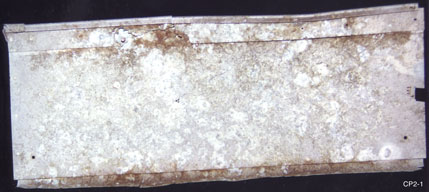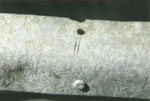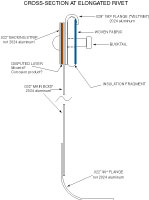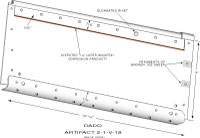 |
October 8, 2003
| Dados Galore |
Artifact 2-1-V-18, the dado recovered from Nikumaroro in 1989. The small rectangular cut-out on the extreme right was made in 1992 by the National Transportation Safety Board laboratory for materials anaylsis. TIGHAR photo by Frank C. Lombardo.
 Especially interesting was the fact that we had the entire assembly rather
than the cut-up scraps of aluminum we usually find in the village – and
there were no part numbers stamped into it anywhere. Virtually all WWII
military aircraft assemblies were festooned with stamped-in part numbers
because they were built in great quantity at diverse locations by a hastily
trained and constantly changing work force. The pre-war Lockheed 10, by
contrast, was built in small batches by a relatively stable group of employees
in a single shop. There were some part numbers cast into major Electra components
such as landing gear legs, and we’ve seen handwritten part numbers on some
components, but no stamped-in numbers. The absence of part numbers on a
complete assembly suggested that the assembly either wasn’t an airplane
part at all or that it came from an aircraft that predated the revolution
in aircraft mass production that began in 1939.
Especially interesting was the fact that we had the entire assembly rather
than the cut-up scraps of aluminum we usually find in the village – and
there were no part numbers stamped into it anywhere. Virtually all WWII
military aircraft assemblies were festooned with stamped-in part numbers
because they were built in great quantity at diverse locations by a hastily
trained and constantly changing work force. The pre-war Lockheed 10, by
contrast, was built in small batches by a relatively stable group of employees
in a single shop. There were some part numbers cast into major Electra components
such as landing gear legs, and we’ve seen handwritten part numbers on some
components, but no stamped-in numbers. The absence of part numbers on a
complete assembly suggested that the assembly either wasn’t an airplane
part at all or that it came from an aircraft that predated the revolution
in aircraft mass production that began in 1939.
Then in November of 1991 we showed it to some senior employees in the “completions shop” (the facility that tailors the interior furnishing of new business aircraft to a specific customer) at Atlantic Aviation here in Wilmington, Delaware. They immediately recognized the assembly as a “lower dado panel” – a baseboard-like non-structural component commonly used in a category of relatively small aircraft known as “cabin class twins,” two-engined airplanes that typically carry between six and twelve passengers in a cabin that is entered via a door in the side.
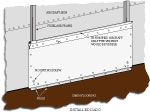 A dado (pronounced DAY-doh) serves as a juncture between the floor and the
fabric-covered interior wall of the cabin, providing protection against
kicks and bumps. Artifact 2-1-V-18 was anchored to the floor by means of
a right-angle flange. The holes in the flange are not a standard rivet size
and the bottom of the flange exhibits what appear to be pry marks immediately
adjacent to the holes, leading us to conclude that his particular dado was
probably nailed to a wooden floor. The Lockheed Model 10 had a wooden floor.
A dado (pronounced DAY-doh) serves as a juncture between the floor and the
fabric-covered interior wall of the cabin, providing protection against
kicks and bumps. Artifact 2-1-V-18 was anchored to the floor by means of
a right-angle flange. The holes in the flange are not a standard rivet size
and the bottom of the flange exhibits what appear to be pry marks immediately
adjacent to the holes, leading us to conclude that his particular dado was
probably nailed to a wooden floor. The Lockheed Model 10 had a wooden floor.
Apparent pry marks. |
Click on the images to open full-sized versions in new windows.
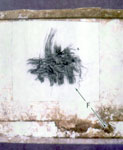 |
Left, fabric fragment. NTSB photo. Right, insulation and fabric fragments on elongated rivet. TIGHAR photo by P. Thrasher. Click on the images to open full-sized versions in new windows. |
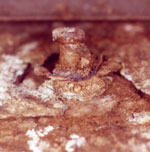 |
On the type of dado recovered from Nikumaroro the insulation and fabric that covered the face was tucked up under a 1/4 inch 180° flange known as a “veltrim.” When installed in a finished aircraft the only visible part of the dado is the thin line of the veltrim.
The metallurgical examinations performed by the NTSB showed that the several components of the dado assembly were made of two different kinds of aluminum.
- 2024 alloy – the standard aircraft structural alloy known in 1937 as “24ST”
and
- an alloy other than 2024
None of the components of the dado is “clad.” Cladding is a corrosion-inhibiting process whereby the alloy is sandwiched between two thin layers of pure aluminum. Patented by the Alcoa company, this type of alumium sheet was known as “Alclad.” All of the structural aluminum sheet on the Lockheed 10 (and the vast majority of other American stressed-aluminum aircraft of the 1930s and ’40s) was Alclad. A dado, of course, is not a structural component and can be made out of less expensive aluminum but it is also much more susceptible to corrosion.
In 1994, TIGHAR member Frank Lombardo undertook a detailed examination of the dado. Frank was retired from a long career in aircraft radio installation and maintenance and was very familiar with aircraft interiors of the 1940s. His report on his findings and his speculations about the dado are in the Project Bulletin previous to this one: The Dado, Part I.
 |
| Station diagram based on a technical drawing by William F. Harney. Used by permission. Click on image to open a large version in a new window. |
Frank also believed that he had found something the NTSB missed. The laboratory report noted that the space between the riveted-together aluminum components was “filled with corrosion products.” Frank, after removing one of the components (something the NTSB did not do) believed that the “corrosion products” were in fact strips of thin (1/16 inch) micarta, an industrial laminate developed by Westinghouse.
To our considerable frustration, we have been unable to find photographs that show the interior of the Earhart Electra after it was repaired following the March 20, 1937 accident. A careful, but by no means exhaustive, search of the engineering drawings for the Model 10 (11 rolls of hard to read microfilm) failed to turn up anything helpful one way or the other.
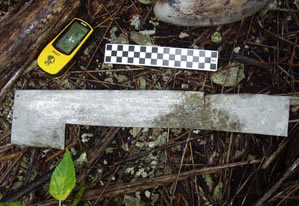 |
Artifact 2-7-V-1, Dado. In situ. In excellent condition. Dark spot
is probably caused by vegetation resting on the surface and rotting.
TIGHAR photo by V. Hunn. |
The “new” dados are in much poorer condition than the 1989 find. 2-7-V-1 has been disassembled, pieces cut out, and one edge folded over several times. Because we’re missing one finished edge we can’t be sure how long it originally was. 2-7-V-2 was mostly buried and is in several pieces. Luckily, it had not been cut up and the finished edges were intact. Through expert recovery technique and good in situ photos, we were able to establish its original dimensions.
An added surprise came when we realized that another artifact collected in 1989, 2-1-V-2, is almost certainly a section of yet another dado. The NTSB had identified the material as non-clad 2024 aluminum of the same thickness (.032 inch) as the non-clad 2024 of 2-1-V-18, and it came from near where the original dado was found, but it wasn’t until we were faced with the fact that there were multiple dados there in various stages of deconstruction that we made the connection.
Artifact 2-7-V-2, Dado. Note fragility of structure
and extreme corrosion. TIGHAR photo by V. Hunn. |
 |
Aside from corrosion, all of the damage seen on the artifacts seems to have been caused by adaptive local use rather than by the force of an accident. The dados were disassembled, rather than forcibly removed, from the original structure by unscrewing the mounting screws and prying up the nails from the back side of the 90° flange. That is not possible unless the removal of the mounting screws enabled the outer structure to which it was attached to be discarded thus permitting access to the back of the dado. This would seem to suggest that the dados were removed from a section of wreckage rather than from an intact aircraft.
That’s the way it appears right now, but appearances can be deceiving and much more research is needed before we can say with certainty where these artifacts originally came from. That research is already well under way. A specialized TIGHAR research team has begun examining both archival records and surviving examples of Electras and other aircraft. Watch for progress reports here and in upcoming issues of TIGHAR Tracks.
|
The drawings of the dado here and above were developed from drawings made by Frank Lombardo, and represent Dado 2-1-V-18 as found in 1989. Click on each small image to open a larger version in a new window. |
||
